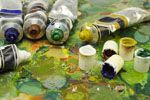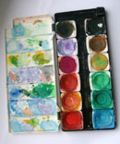High Quality Custom Portraits
High quality custom painted oil portraits and amazing customer service are what you will find at Guaranteed Portraits. Our talented portrait artists will paint a personalized portrait from your photos.
Select
Our Portrait Galleries

Painting Techniques Compared
Portrait artists incorporate different painting techniques in to their works of art. Oil, acrylic, pastel, charcoal and watercolor are widely used. Each one of these techniques has its own advantages and disadvantages which you should take into account when ordering a custom portrait.
Oil Painting
 From the invention and the popularization of oil painting in the 15th century by the Flemish, Italian and Venetian painters, oil paint has become an unrivalled method of expression for all fine artists. Oil paints give paintings a sense of realism that is difficult to achieve with other painting techniques. The brightness achieved by the colors, the effect of the brushstrokes on the final painting, the dramatic and intense elements which can be achieved by oil portraits and the level of detail make this technique the most widely used and most prestigious among all the painting techniques. Moreover, the fact that oil paint takes considerable time to dry makes corrections very easy. This facilitates the job of the artist which is often revealed in the final painting.
From the invention and the popularization of oil painting in the 15th century by the Flemish, Italian and Venetian painters, oil paint has become an unrivalled method of expression for all fine artists. Oil paints give paintings a sense of realism that is difficult to achieve with other painting techniques. The brightness achieved by the colors, the effect of the brushstrokes on the final painting, the dramatic and intense elements which can be achieved by oil portraits and the level of detail make this technique the most widely used and most prestigious among all the painting techniques. Moreover, the fact that oil paint takes considerable time to dry makes corrections very easy. This facilitates the job of the artist which is often revealed in the final painting.
Oil painting is one of the most respected, challenging and rewarding art forms today. Oil paints produce engaging images that can be moved and manipulated with each layer. Many of the most famous and recognizable art pieces are oil portraits. However,other techniques such as acrylic, pastel, charcoal and watercolor also have their own advocates.
Acrylic Painting
Acrylic is also an appreciated painting technique and has some distinct advantages: paintings stand out because of their velvet brightness and their luminosity, but also because of their resistance to environmental agents such as light which delays aging of the painting. Acrylic paint, a pigment suspended in an acrylic polymer emulsion, is fast drying and can be diluted with water. Once the acrylic is dry, it usually becomes water resistant. Moreover, the fact that this type of painting is easy to handle and dries in minutes is perhaps one of its main advantages for some painters, especially if corrections are not required. A disadvantage to the fast drying time is the difficulty to make corrections once the painting has dried. Consequently, painters need to work faster in order to avoid the colors from drying on their palette.
Pastel Painting
 Although pastel painting was born as a complement to drawing in paintings, it is currently very well known in all themes, concepts and styles. The mass formed when mixing the pigment dusts with glue was called pastel and gave name to this traditional technique. Pastel painting began with the purpose to give volume and a more realistic appearance to drawn pictures which soon evolved into an independent technique. Perhaps one of its greater advantages is the speed granted by this technique; there is no need for drying time which allows for greater expression and the instantaneous and accurate correction of details. Its versatility and the possibility to paint and draw with fine superposed lines, a fine glazing, saturated colors and “impasto” makes it an interesting material for the painting of a portrait. The drawbacks of pastel media usually stem from the medium’s fragile nature. If touched, the media can be easily smudged or darkened.
Although pastel painting was born as a complement to drawing in paintings, it is currently very well known in all themes, concepts and styles. The mass formed when mixing the pigment dusts with glue was called pastel and gave name to this traditional technique. Pastel painting began with the purpose to give volume and a more realistic appearance to drawn pictures which soon evolved into an independent technique. Perhaps one of its greater advantages is the speed granted by this technique; there is no need for drying time which allows for greater expression and the instantaneous and accurate correction of details. Its versatility and the possibility to paint and draw with fine superposed lines, a fine glazing, saturated colors and “impasto” makes it an interesting material for the painting of a portrait. The drawbacks of pastel media usually stem from the medium’s fragile nature. If touched, the media can be easily smudged or darkened.
Charcoal Painting
 With regard to the means available to draw portraits, charcoal is, perhaps, the most versatile. The facility with which sketches can be completed and the speed at which errors can be corrected by the simple application of a piece of cloth makes it a favorite of many portrait painters and sketch artists. Perhaps the only disadvantage is that the works made with this material are always in black and white and lack all the elements which are effectively conveyed by colour. Experienced portrait painters use diverse tones and shades of grey mixed with the background to attempt to convey what colors communicate in real life without their actual presence.
With regard to the means available to draw portraits, charcoal is, perhaps, the most versatile. The facility with which sketches can be completed and the speed at which errors can be corrected by the simple application of a piece of cloth makes it a favorite of many portrait painters and sketch artists. Perhaps the only disadvantage is that the works made with this material are always in black and white and lack all the elements which are effectively conveyed by colour. Experienced portrait painters use diverse tones and shades of grey mixed with the background to attempt to convey what colors communicate in real life without their actual presence.
Watercolor Painting
 Dry powder pigments, soluble in water and mixed with Arabic rubber, gave rise to watercolors or aquarelle. Applied with a brush on paper and dissolved in distilled water, watercolors produce pictures of a fine transparency. Nevertheless, this same characteristic makes it difficult to disguise any errors made and the correction of these can easily ruin the final painting Watercolors lack the rich palette of colors and the intesnity found in other painting techniques. In fact, many artists find it difficult to achieve the proper lucidity and differences in color, shade and light in their paintings, since the color palette is limited and the colors less intense. Details are also difficult to achieve. Regardless, some artists prefer the use of watercolor since the pictures painted with this technique reveal a delicate romanticism.
Dry powder pigments, soluble in water and mixed with Arabic rubber, gave rise to watercolors or aquarelle. Applied with a brush on paper and dissolved in distilled water, watercolors produce pictures of a fine transparency. Nevertheless, this same characteristic makes it difficult to disguise any errors made and the correction of these can easily ruin the final painting Watercolors lack the rich palette of colors and the intesnity found in other painting techniques. In fact, many artists find it difficult to achieve the proper lucidity and differences in color, shade and light in their paintings, since the color palette is limited and the colors less intense. Details are also difficult to achieve. Regardless, some artists prefer the use of watercolor since the pictures painted with this technique reveal a delicate romanticism.
Overall, a beautiful painting is what matters, regardless of the technique used. This can be achieved by a specialized artist in any of their chosen mediums. Certain artists enjoy the speed and the monochrome compositions of pastel and charcoal, whereas others prefer the ethereal look of watercolor paintings. Still others advocate for the solidity and the level of detail of acrylic and oil paints. Artists who enjoy painting portraits often experiment with all these varied and rich techniques.












